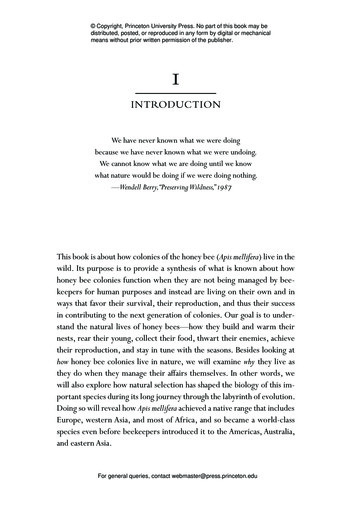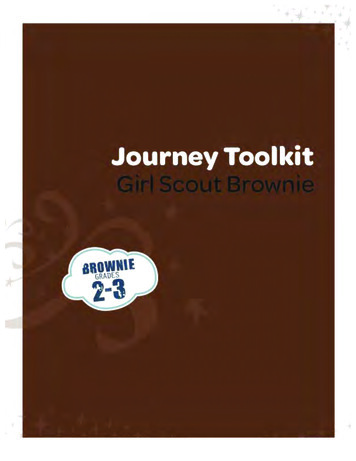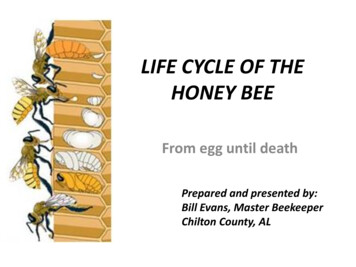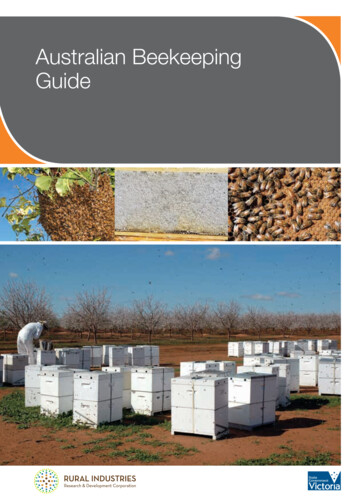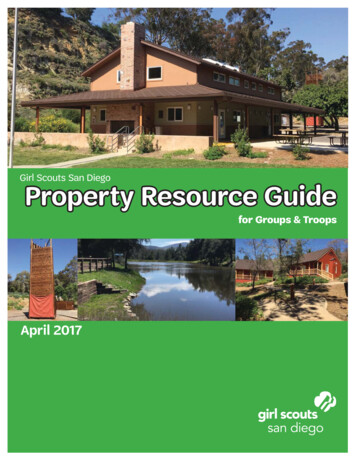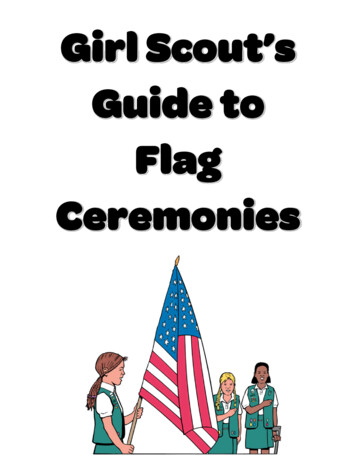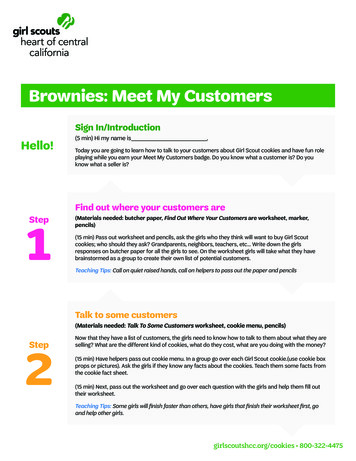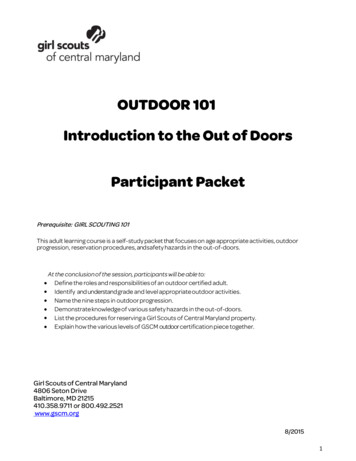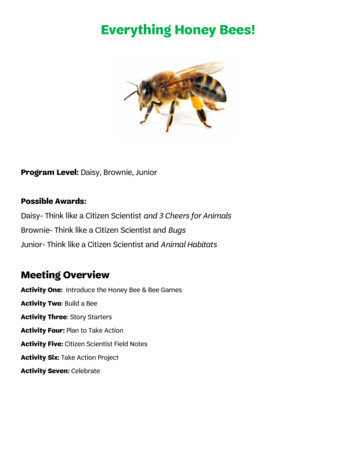
Transcription
Everything Honey Bees!Program Level: Daisy, Brownie, JuniorPossible Awards:Daisy- Think like a Citizen Scientist and 3 Cheers for AnimalsBrownie- Think like a Citizen Scientist and BugsJunior- Think like a Citizen Scientist and Animal HabitatsMeeting OverviewActivity One: Introduce the Honey Bee & Bee GamesActivity Two: Build a BeeActivity Three: Story StartersActivity Four: Plan to Take ActionActivity Five: Citizen Scientist Field NotesActivity Six: Take Action ProjectActivity Seven: Celebrate
Introduce the Citizen Science Kit with the discussion topics and questionsToday, we are starting a new Journey where we are going to be citizen scientists!Does anyone know what scientists do? Scientists study different parts of nature to understand how it works.They use something called the scientific method. The scientific method is the name for the stepsthat scientists take to learn new things. On this Journey, you're going to use the scientific method to help real-life scientists learn moreabout the world.You're going to do something called citizen science. A scientist asks regular citizens -- that's you and me - to help her out.Close the Citizen Scientist Kit with the discussion topics and questions: Can each of you give an example of something you learned on this Journey?Would you be interested in completing another Citizen Science project? If so what topic wouldyou like to cover?Each of you have something special to contribute to others. Citizen science brings togetherpeople of all different backgrounds to add to the world's scientific knowledge.You have earned your Think Like a Citizen Scientist award, which means you learned how tosolve problems and answer scientific questions like a scientist. You completed a citizenscience project, where you collected and recorded data to help a real scientist to do her work!
Activity One: Introduce the Honey BeeMATERIALS: Bees model (4 pieces)Bee life cycleGroup Discussion Questions: Raise your hand if you like bees?Raise your hand if you don’t like bees?How many of you have ever met someone you didn’t like and then after you got to know themyou liked them?How many have ever said you didn’t care for a food and then you tried it and liked it?Honey Bees get a BAD RAP! My challenge is to help you become friends with the honey bee!Some of you might ask why would anyone want to be friends with honey bees? Let’s explorethat question!First let’s look at the life cycle of a bee.You will learn that:1) Honey Bees have cool bodies!2) Honey Bees have super powers!3) Honey Bees have funny personalities!4) Honey bees help our world!
Activity One: What kind of bee are you?Honey bees develop in four distinct life cycle phases: egg, larva, pupa, and adult. The totaldevelopment time varies a bit among the three castes of bees, but the basic miraculousprocess is the same: 24 days for drones, 21 days for worker bees, and 16 days for queens.
Talking Points: There are 3 types of bees in each honey bee hive: Queen, Drone and WorkerQueen Bee Only one queen bee lives in every hive. She communicates to her hive by letting off a perfume scent or pheromones and also by tinyvibrations. All the bees in the hive know their queen bee! The queen bee can lay up to 3,000 eggs per day. The queen bee spend the entire day being cleaned and fed by the worker bees. If a hive is agitated it means they have a bad queen bee and bee-keepers can replace her to calmdown their hive.Drone Bees There are only a few Drone bees in each hive. They are all male Drone bees sleep and eat all day Drone bees are fed by the worker bees Drone bees are kicked out of the bee-hive each winterWorker Bees Worker Bees are all female There are between 30,000 to 50,000 worker bees in each hive! Worker bees spend their days collecting pollen from flowers and bringing it back to the hive. The pollen is stored in pockets on their hind legs. Worker bees clean and feed the queen and drones*After discussion time, encourage girls to join in the two Honey Bee Games.Activity One: Honey Bee Games
Materials: Mini bucketsPing pong balls1) Collecting pollen game: There are a variety of ways to play relay races using mini balls and buckets. The main goalis for teams to race each other and get all the balls into the buckets. Version One: Divide up girls into teams. The first girl on each team will run one ball andtoss it into an empty bucket. Choose one girl to hold the bucket, this will be the team,“Queen Bee.” Do this with everyone in line until one team’s bucket is empty.Version Two: Have the girls line up shoulder to shoulder and pass the balls down the lineuntil each ball makes it into the bucket. See which team empties their bucket first. *Discuss with girls that this is what the workers bees do each day when they visit flowers and returnto the hive.2) What kind of BEE are you game: This is a fun way for girls to use improv/acting skills to act out the different bees they havelearned about. This game is very similar to “Simon Says” but using the different bees inthe hive. Call out the different kinds of bees and encourage the girls to act like each type ofbee. Switch it up and go faster and slower calling out each type of bee. Drones- Sleepy, lazy and eat a lot!Queen- Dainty, prim and proper, shakes, quivers and makes buzzing noises to calm herhive.Worker bee- flies around, cleans the hive, feeds others, super strong and works hard!
Activity Two: Build-a-BeeMaterials: Bee Parts sheetGlue sticksScissorsTalking Points:Honey Bees have cool bodies! Did you know that bees have 5 eyes that look like 2 giant eyes! The Thorax and abdomen are the largest part of the bee. Bees can see colors we can see like ultra violet Did you know that worker bees have pouches on the sides of their legs to collect pollenand when it gets too heavy they empty it in the hive? Bees have 6 legs like most insects Bees bodies are covered with lots of hair Honey bees don’t like to sting because if they lose their stinger they will die.Activity: After discussion girls can cut, assemble and glue their own bee using the materials provided.Allow girls to check the sample and be able to identify the parts of the bee as they go along.Allow time at the end of this rotation for girls to share their bees!
Activity Three: Story StartersMonica and the Bee KeeperLast year Monica’s family moved into a new house off acountry road with lots of land to run and explore. Thishouse was very different than the city apartment they hadcome from. One of Monica’s favorite new discoveries washer neighbor, Mr. Sullivan, who was a bee keeper. Mr.Sullivan had been keeping bees for 20 years and hisproperty was filled with small white bee boxes. EverydayMonica would watch Mr. Sullivan check his bee boxeswearing a white suit and vale.One morning Mr. Sullivan asked Monica if she wanted tocome over and see some of the bee boxes and learn about his bee keeping hobby. At first Monica wasscared and couldn’t imagine why someone would want to keep bees as a hobby. The only thing Monicaknew about bees is that they hurt when they stung her. After talking about it with her mom, Monicadecided to give it a try and the two of them ventured over to see the bees!To Monica’s surprise she has a fantastic day at Mr. Sullivan’s bee boxes. She learned so much about beekeeping that she couldn’t wait to run home and tell her the rest of her family! Monica learned that beesgenerally do not sting their keeper and that Mr. Sullivan had only been stung one time in his 20 years ofbee keeping. She also learned about the importance of bee keepers. The honey bee is in great danger!Their numbers are declining due to prairies and wildflowers being mowed down for construction.Monica also learned that bees are super sensitive to insecticides and entire hives can die off if they areexposed to man-made chemicals. The saddest part was learning that if we lose our bees, we also losethe wonderful fruit and flowers the bees pollinate for us.At first Monica felt helpless learning about the disappearing honey bees, but then she decided to get intoaction and create a plan to help save the bees!Activity: Ask girls to divide up into several teams and act out different endings for this story.Using the poster boards and markers, have your team draw an ending to this storyBe creative as you want! Make sure each person on the team adds to the project . .
Activity Four: Plan to Take ActionWe are protectors of the Honey Bee!MATERIALS: Large pieces of paper or poster boards Markers Post-It notes Pens and pencilsQuestions for DiscussionWhy is the Honey Bee population declining? Cutting down and mowing of their habitats such as fields, meadows and forest. The use of chemicals on lawns and crops.Why is important to save the Honey Bee? Honey Bees help produce much of the fruits and vegetables we eat. Honey Bees pollinates flowers which make more flowers.How can we protect the Honey Bee? Use earth friendly products in our home and on our lawns. Educate others on the plight of the honey bee. Work with different organizations that push for earth friendly farming and make lawsagainst using harmful chemicals.How can we create our own Bee friendly habitat? Create a special spot at our home to plant Bee friendly flowers. Work with community organizers to dedicate land for planting bee friendly flowers andplants.DO: Have girl’s brain storm ideas for their take action project.Have them write their ideas on post it notes and stick them to the poster boards.Lead girls to vote on their project.
Activity Five: Citizen Scientist Field NotesMATERIALS: Overview of Citizen Science project found on ZomBee Watchhttps://www.zombeewatch.org/theproject Any additional materials needed for your chosen take action project Field notes: a small notebook or notebook paper Pens or pencilsSAY: DO: As Citizen Scientists, we will join thousands of people across the country who are helpingto protect the Honey Bees.As girls do the project, remind them of the skills they're using -- and that those are skillsthat scientists use every day:o Observation - they'll look very closely at the world around them.o Gathering data - they'll write field notes, taking photos, take measurements, etc.o Analyzing data - they'll send their data to a scientist who will combine it with datafrom many other people and then analyze it.Tell them that you will be sending their data to an online site for the scientist to analyze. Byhelping a scientist analyze her data, they are working like scientists.After the meeting, make sure to encourage your girls to continue to submit sightings athttps://www.zombeewatch.org/theprojectAbout the project:ZomBee Watch is a citizen science project sponsored by the San Francisco State UniversityDepartment of Biology, the San Francisco State University Center for Computing for Life Sciences andthe Natural History Museum of LA County.Honey bees infected by the Zombie Fly leave their hives at night and are attracted to nearby lightswhere they become stranded and eventually die. The presence of fly larvae in up to 18% of activeforagers in some California honey bee hives makes the Zombie Fly a potential contributor to hivedeclines. This would be especially likely if Zombie Fly infection is widespread and higher in areas thatare experiencing hive declines.There are many ways you can get involved. It can be as easy as collecting honey bees that are underyour porch light in the morning, under a street light or stranded on sidewalks.To test for the presence of Zombie Fly infection all you need to do is put honey bees you collect in acontainer and observe them periodically. Infected honey bees give rise to brown pill-like fly pupae inabout a week and to adult flies a few weeks later.
Activity Five Continued: Practice Taking Field NotesMATERIALS: Bee photos Field notes Pens, pencils or markersPREP:10 minutes before meeting- Place the bee photos in different places around the room.SAY: How do scientists remember what they observe? Taking notes about what you see is an important part of being a scientist. What do youthink they'd want to take notes about? What if you were taking notes on squirrels in your back yard? What things would you writedown? Now, you're going to have a chance to take field notes like a scientist! Today, we're going to pretend we're helping a scientist learn more about bees. Thescientist has asked you, as citizen scientists, to tell her about the bees in this room.DO: SAY: Have girls walk around the room and look at the bees.Have them draw anything they want to remember about the bees, including how manythere are and what they look like.Advise them to pay super close attention to all of the details and are constantly thinkingabout what their observations might mean.If possible, walk with the girls so they can talk about what they see.If you have a large group, you may need to have girls divide into smaller groups and haveother adults help facilitate this activity.As they observe, remind girls that they can remember what they see by drawing a picture.Girls can also create tallies for how many bees they see.What did you notice about the bees you saw?If a scientist was taking field notes on the bees, what are some other things she mightwant to remember?Scientists want to remember everything about what they observe.They write down the date and where they were when they made their notes.All your notes are called data. Data simply means information. It can be notes, drawings,photos, recordings or videos.Let's look at your data.Today, you did what scientists do -- you used the scientific method. You madeobservations. You recorded data. And you looked for patterns in your data.
Optional ActivitySweet Sampling All Different Types of Honey!Did you know that the color and taste of honey depends on the region thebees come from and the types of flower they get nectar from?Create a game for your Girl Scouts:1) Set out 4 un-labeled jars of honey from different regions and differentflowers.2) Create index cards with the name and region of each honey. Example,clover honey from South Texas.3) Vanilla wafers or other small flat cookies are great for dipping andsampling honey.4) After the girls taste each honey. Let them try to line up the cards in frontof each jar, guessing which card identifies each honey.*Caution! Make sure you check your troop’s allergy list before doing this activity!
Activity Six: Take ActionMATERIALS: Large pieces of paper or poster boards Markers Post-It notes Pens and pencilsSAY: Today, you'll be designing your Take Action project!You brainstormed and chose one project to work together on as a group.Now, you know what your project is, but you might not be quite sure how to make it happen.Today, think about all the little details you might need to consider, and bring them together toform a plan on how you will Take Action to help others!DO: DESIGNING OUR TAKE ACTION PROJECTDivide girls into small teams of 3 - 4 to design their Take Action project.Brainstorm and Design. Have girls brainstorm in their small groups. Have girls share their ideas with the larger group. Write girls ideas on a whiteboard or poster board Offer things for girls to think about, depending on what they want to do.If girls want to make a video, how will they film it? What do they want to say? Do they want to wear costumes? Do they want to use music? How will they show it to people – at a school assembly, at a gathering of their families, byhaving an adult post it (safely) online?If girls want to create posters for their school, what materials will they need? Who can they ask for permission to put the posters on the walls? How should they ask for permission – if they want to make a presentation to the principal,what should they say? Once they get permission, what should the posters say? What will they look like? When do they want to hang up the posters? Do they want to get other students to join them?Tips for Leaders Keep it Girl-Led by giving just one or two examples and then seeing where the girls take it.Remind them that good teamwork is important. Encourage girls to take turns, and make sureeach girl has a role.You may need to pave the way for girls to Take Action by calling the school or town officials toget permission for what they want to do or set up a time for girls to meet the officials to maketheir Take Action proposal.Keep a list of the "to do" items, for example: materials they need, people they need to talk to,etc.
Possible Take Action ProjectSave the Bees GardeningTalking Points:The Honey Bee is a great producer of great things!Did you know that- 1/3 of our fruits and veggies come from bees pollinating our flowers!Did you know that- Without bees we will lose many flowers, fruits and veggie that we love!How do you think it would be if we went to our grocery store without bees in the world?How do you think we can save our bees?Now that we know how important it is to save our bees, did you know that you can help savethem right in your own yard or community?I bet we can start today! Scientist, botanists, gardeners and bee keepers now know that bees like certain flowers.These flowers are usually brightly colored.These flowers are called perennials a fancy word for “they come back every year” and areeasy to grow.You can take home your mini-garden starter bag and plant it in your yard, a container or apark.Have your family help keep a journal to see what kinds of flowers come up and if any honeybees are spotted.Activity After discussion time encourage girls to create their own mini-take home gardens using thesoil and the Save-the-Bee-Seeds. Using Zip-lock bags, let each girl measure their soil, addtheir seeds and shake their bags. Leaders can also supply egg cartons, recycled products or other small containers for girls toplant their seeds.
Activity Seven: Celebrate!MATERIALS:Girl Scout Promise and Law poster(s)Any items Brownies want to display (such as photos or videos from their citizen science or TakeAction projects) Photos and videos from the Journey meetings Music Decorations Snacks *Think Like a Citizen Scientist award *Take Action award*Note to Volunteers: You can buy these awards from your council shop or on the Girl Scouts'website. SAY:Can each of you give an example of something you learned on this Journey?Please step forward when I say your name to accept your awards.You have earned your Think Like a Citizen Scientist award, which means you learned how to solveproblems and answer scientific questions like a scientist. You completed a citizen science project,where you collected and recorded data to help a real scientist to do her work!And you have earned your Take Action award because you did something to make the world abetter place.Now, you'll start your celebration!Refer to closing discussion topics and questions on page 2DO: Have girls help set up the meeting room by putting up posters and decorations. Make surethey greet guests as they walk in and offer them a snack.Recite the Pledge of Allegiance and the Girl Scout Promise and Law. Then, have themintroduce any special guests.Girls stand in front of guests and share one thing that they learned while they were on theThink Like a Citizen Scientist Journey or while doing their Take Action project.They can make this into a "show and tell" by showing photos or video from their citizenscience and Take Action projects.Include any activities -- such as taking photos, dancing or singing a special song--that girlsdecided to do as part of the celebration.
Materials List:Please be sure to return the following items.Laminated curriculum and meeting aidsBee model (4 pieces)8 Glue sticks12 Scissors2 Marker setsTweezers20 mini balls3 Mini BucketsGirl Scouts leave thingsbetter than they foundthem.
toss it into an empty bucket. Choose one girl to hold the bucket, this will be the team, "Queen Bee." Do this with everyone in line until one team's bucket is empty. Version Two: Have the girls line up shoulder to shoulder and pass the balls down the line until each ball makes it into the bucket. See which team empties their bucket first.
